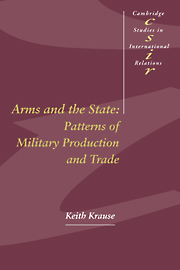Book contents
- Frontmatter
- Contents
- List of figures
- List of tables
- Acknowledgements
- Introduction
- 1 Motive forces in the evolution of the arms transfer and production system
- 2 The emergence of a global arms transfer and production system
- 3 From the Military Revolution to the Industrial Revolution
- 4 An overview of the post-1945 global arms transfer system
- 5 The dominance of first-tier producers and suppliers
- 6 Second-tier producers and suppliers: the struggle to keep pace
- 7 Dependent production and exports in the third tier
- 8 The subordinate role of arms recipients
- Conclusion
- Appendix: Arms transfer data sources and problems
- Notes
- Bibliography
- Index
1 - Motive forces in the evolution of the arms transfer and production system
Published online by Cambridge University Press: 22 September 2009
- Frontmatter
- Contents
- List of figures
- List of tables
- Acknowledgements
- Introduction
- 1 Motive forces in the evolution of the arms transfer and production system
- 2 The emergence of a global arms transfer and production system
- 3 From the Military Revolution to the Industrial Revolution
- 4 An overview of the post-1945 global arms transfer system
- 5 The dominance of first-tier producers and suppliers
- 6 Second-tier producers and suppliers: the struggle to keep pace
- 7 Dependent production and exports in the third tier
- 8 The subordinate role of arms recipients
- Conclusion
- Appendix: Arms transfer data sources and problems
- Notes
- Bibliography
- Index
Summary
To understand the evolutionary dynamic of the global arms transfer and production system, one must first untangle the forces that generate the demand for the production and trade in weapons and second, explain the way in which this demand may change over time. Thus this chapter will begin by expanding upon the motive forces briefly outlined in the introduction – the pursuit of wealth, power and victory in war – to sketch the way in which these may shape the emergence and evolution of the global arms transfer and production system. The second section will focus on the processes of technological innovation and diffusion in the arms transfer system. The final section will outline the structure of the arms transfer system this analysis suggests. This chapter thus both presents the argument in skeletal form to be measured against the evidence to follow and provides some organising principles for that evidence.
Two important difficulties with this approach should be acknowledged at the outset: a wide gulf separates the scholarship that concentrates on different sets of forces identified here as fundamental, and there is no consensus on the process of change in the international system on which one could easily erect an analysis of the evolution of arms transfers and production.
- Type
- Chapter
- Information
- Arms and the StatePatterns of Military Production and Trade, pp. 12 - 33Publisher: Cambridge University PressPrint publication year: 1992

